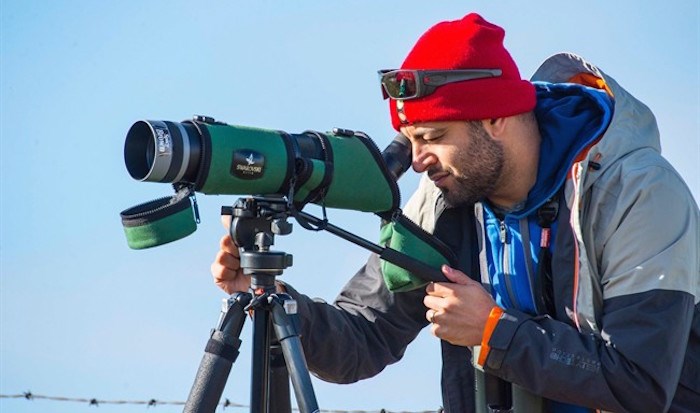Yousif Attia wasn’t exactly a typical teenager. He had always been fascinated by birds, and he wanted to participate in a local Christmas bird count — an annual event where people across North America note the number of fowl in the Western hemisphere.
No one at his Calgary high school shared quite the same passion for ornithology, but fortunately it was the late 1990s and local birdwatching groups were just a few clicks away on the internet. Attia found his community.
“I found a mentor who kind of took me under his wing, as far as driving me around and taking me on Christmas bird counts with him and then encouraging me to lead walks myself,” said Attia, now a 35-year-old tour guide. “It kind of took off from there.”
More young people like Attia are flocking to birdwatching than ever, aided by the internet, social media and digital photography, avian enthusiasts say. While previous generations had to dust off old bird books at the library, millennials have easier access to information and like-minded individuals than ever before.
Attia was among the thousands of people who descended upon Vancouver in August for the International Ornithological Congress, a global gathering of highly respected bird scientists held every four years. It is the first time the sought-after event was staged in Canada since the 1980s, and convener Robert Elner pushed to bring it to British Columbia.
“It’s a sense of incredible pride, not for myself but for Canada to actually host this. This is a real big endorsement of Canadian science and basically Canadian culture,” said Elner, a scientist emeritus with Environment Canada.
Organizers partnered with the inaugural Vancouver International Bird Festival, which was held the same week and featured such millennial-friendly events as fowl-themed improv comedy, a laid-back nature walk dubbed “Return of the Hipster Birder,” and bird-inspired outdoor yoga.
Festival chairman Rob Butler has observed the demographics of birdwatching change.
“It used to be the purview of generally retired people, but it’s really becoming much younger. The average age is now in the high 40s, early 50s, because the people have a bit of money and can travel,” he said. “But it’s coming down.”
Travellers who are entirely focused on seeing rare birds are relatively few, while most want a broader cultural experience that involves birds, said Butler.
That’s why the festival is “all about connecting you to culture through birds,” he said.
Cam Gillies, owner of Eagle-Eye Tours, which facilitates guided bird tours in dozens of countries, said most of his clients want a tour that features some birds but also includes other animals and natural wonders.
More people in their 30s are signing up for his tours than ever, Gillies said, driven by the rise of digital photography and websites like Instagram and Facebook.
“You can fill the frame with some beautiful bird, which normally would have taken thousands of dollars of camera equipment and a really big lens to achieve,” he said. “People are now able to capture those images and share them on social media.”
Some millennials are pushing the artistic limits of bird fandom even further. Hillary Esdaile, 33, and Jennifer Miller, 36, are artists and birdwatchers who have created full, lifelike avian costumes, which they wore to the opening ceremony of the congress.
Miller said her elaborate costume depicting a bearded vulture — a near-threatened bird of prey — is a fun way to spark conversations about protecting wildlife.
“I really like being able to engage with people. They might not know about the species that I’m costuming as,” she said. “To let people learn about this bird through this interactive costume has been very rewarding to me.”
– Laura Kane, The Canadian Press
For the Prince George birds: species to keep an eye out for
There are more than 270 birds flying about North-Central B.C. for keen ornithologists, including hawks, eagles, falcons, vultures, swans, loons, pelicans, cranes, gulls, nuthatches, finches, grebes and more.
Local bird enthusiast Jack Bowling suggests those wanting to catch a glimpse — or 'gram (as in Instagram) — of local birds set up at one of these several locations within 10 minutes from downtown.
Cottonwood Island Park
Look for woodpeckers and eagles year-round, while warblers, swifts and wood ducks are easy to spot from May-July.
Hudson's Bay Wetland
There are mallards, bufflehead and scaup ducks a'plenty, as well as red-winged blackbirds, yellowthroats, chickadees and warblers.
Connaught Hill Park
This is the spot for stunning views of raptors, gulls and merlins (a type of falcon) soaring through the sky with downtown in the background. You can also spot passerines, warblers, kinglets, chickadees and nuthatches.
McMillian Creek Regional Park
Head to the south end of the park for a great vantagepoint of hawks. In May, this is also where you'll want to catch a glimpse of ospreys fishing in the Nechacko River. The older growth forest is also home to many woodpeckers, flycatchers and warblers.
Forests for the World
If you're looking for variety, you've come to the right place. This site is home to flycatchers, hummingbirds, juncos, sparrows, tanagers, thrushes, vireos and warblers. Ducks can be found enjoying nearby Shane Lake, of course.
Cranbrook Hill Greenway
A walk along this impressive trail will tick off plenty of birds on your to-spot list, including finches, flycatchers, kinglets, redstarts, sparrows, tanagers, vireos, warblers and waterthrushes.
Pineview area
This flat, open space is the best place within 10 minutes of downtown to eye hawks, kestrels, blackbirds, magpies and more during the summer months. In the winter, it's home to hawks, owls and occassionally a rare Gyrfalcon.



